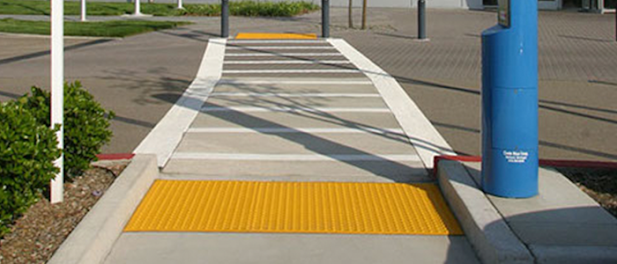Enhancing Accessibility with ADA Approved Detectable Warning Surfaces
In the realm of accessibility and safety, ADA approved detectable warning surfaces play a pivotal role in creating inclusive environments for all. These tactile paving solutions are designed to assist individuals with visual impairments, promoting safe navigation and independence. In this article, we will delve into the significance of ADA approved detectable warning surfaces and explore their various applications.
Understanding ADA Approved Detectable
Warning Surfaces
ADA (Americans with Disabilities Act) compliant detectable warning surfaces are specialized tactile tiles or panels installed on pedestrian pathways, transit platforms, and other public spaces. These surfaces feature a distinct pattern of raised domes or truncated domes, providing a tactile indicator for individuals with visual impairments. The purpose of these detectable warnings is to alert pedestrians about upcoming changes in the walking environment, such as approaching intersections, transit platform edges, or hazardous areas.
Key Features and Benefits
1. Tactile Guidance:
ADA approved detectable warning surfaces offer tactile feedback to individuals with visual impairments, guiding them safely through urban environments. The raised domes can be felt underfoot, alerting pedestrians to changes in their path.
2. Durability and Weather Resistance:
Constructed from durable materials, these surfaces are designed to withstand the rigors of various weather conditions. This ensures their longevity and effectiveness in providing reliable guidance year-round.
3. Compliance with ADA Standards:
Strict adherence to ADA standards is essential for ensuring that detectable warning surfaces meet the required specifications. This compliance guarantees that the installations are effective and meet the needs of individuals with disabilities.
4. Versatile Applications:
ADA approved detectable warning surfaces find applications in a wide range of settings, including sidewalks, crosswalks, transit platforms, and pedestrian ramps. Their versatility makes them a crucial element in creating universally accessible environments.
The Installation Process
The installation of ADA approved detectable warning surfaces involves careful planning and execution to ensure optimal functionality. Professionals follow specific guidelines to determine the appropriate location, spacing, and alignment of these surfaces, taking into account the needs of pedestrians with visual impairments.
Conclusion
Incorporating ADA approved detectable warning surfaces into public spaces is a proactive step towards fostering inclusivity. By providing tactile guidance to individuals with visual impairments, these surfaces contribute to the creation of safer and more accessible communities. Whether in bustling urban centers or quiet suburban areas, the implementation of these surfaces reflects a commitment to making public spaces welcoming for everyone.




Comments
Post a Comment